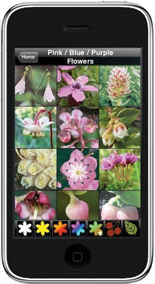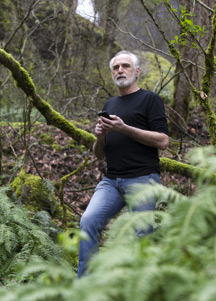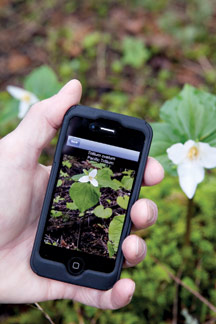
IRIS login | Reed College home Volume 90, No. 2: June 2011
Reediana
Daniel Mathews ’70
Northwest Mountain Wildflowers
By Anne Laufe ’86

I’ll begin with this caveat: I don’t own a smart phone. I’d never even put my hands on one until I wrote this review. But apps like Northwest Mountain Wildflowers might be enough to convert me.
I’ve been a fan of Dan’s work ever since an old Reed boyfriend gave me a copy of Cascade-Olympic Natural History over 20 years ago. Since then I’ve lugged that field guide, which must weigh three pounds, on nearly every hike I’ve taken. I’ve laughed at Dan’s description of Eriogonum pyrolifolium, also known as “dirty socks”; pored over the photographs of towhead baby in both its flowering and seed-head stages; and followed his advice never to eat camas of any kind.
Now Dan has published a digital edition of the wildflower section that is packed with information, putting hundreds of photographs and descriptions at your fingertips, but that weighs less than five ounces (the weight of an iPhone). Now when I’m on the trail wondering what that delicate white flower is, I can just pull out my borrowed iPhone and discover that it’s a narrowleaf arrowhead, which Dan informs us is often found in ponds, marshes, and lakeshores at low to mid elevations.


Photos by Vivian Johnson
And because it’s not web based, you don’t have to be in signal range for the app to function, truly making it like a book in your pocket—only better (something I never thought I would admit).
The app also allows you to conveniently narrow your search by entering your location, and includes Dan’s lively commentary on the natural history of many of the plants. Did you know, for example, that several species in the aster family have alpine populations that reproduce by cloning?
The design isn’t flawless (some clunky graphics and cluttered windows), but is easy to use, even for nontechies like myself. Dan is planning a companion app, Northwest Mountain Trees and Shrubs, later this year. Maybe by then I’ll have my own iPhone.


LATEST COMMENTS
steve-jobs-1976 I knew Steve Jobs when he was on the second floor of Quincy. (Fall...
Utnapishtim - 2 weeks ago
Prof. Mason Drukman [political science 1964–70] This is gold, pure gold. God bless, Prof. Drukman.
puredog - 1 month ago
virginia-davis-1965 Such a good friend & compatriot in the day of Satyricon...
czarchasm - 4 months ago
John Peara Baba 1990 John died of a broken heart from losing his mom and then his...
kodachrome - 7 months ago
Carol Sawyer 1962 Who wrote this obit? I'm writing something about Carol Sawyer...
MsLaurie Pepper - 8 months ago
William W. Wissman MAT 1969 ...and THREE sisters. Sabra, the oldest, Mary, the middle, and...
riclf - 10 months ago